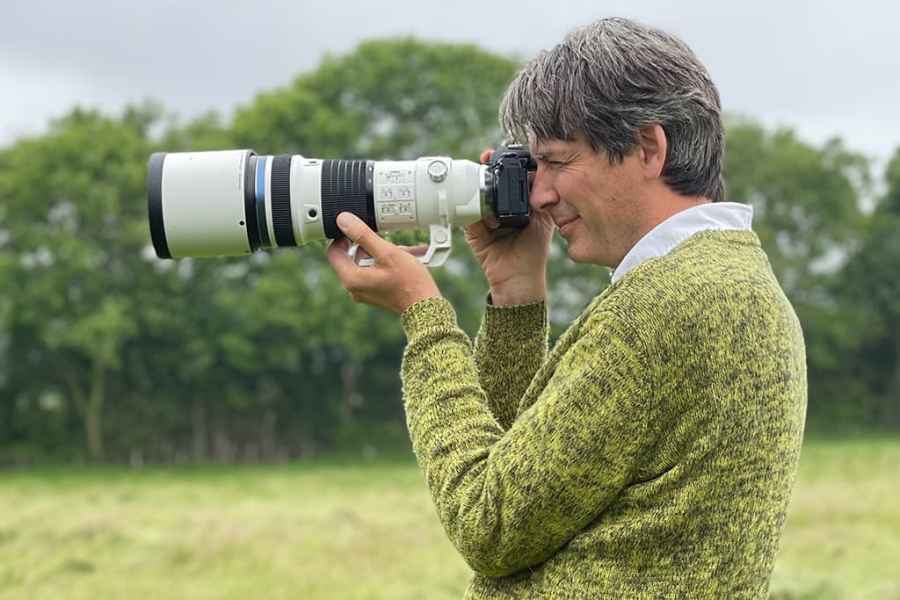When Olympus Cameras (now OM Digital Solutions) announced the development of a 150-400mm f/4.5 lens with a built-in switchable 1.25x teleconverter, it looked like a game-changer to Micro Four Thirds wildlife shooters like myself. After two years the OM System 150-400mm f/4.5 TC 1.25x IS Pro is still in such high demand that it continues to sell out, but is back in stock along with the OM System M.Zuiko Digital ED 90mm F3.5 Macro IS PRO.
OM System 150-400mm f/4.5 TC 1.25x IS Pro – At a glance:
- $7,500 / £6,700
- 300-800mm equivalent range
- 375-1000mm at f/5.6 via built-in 1.25x teleconverter
- 28 elements in 18 groups; built-in TC 7 elements in 4 groups
- 1.3 metres minimum focus
- Weighs 1.875 kg without lens hood
- Up to 8 stop stabiliser with 5-axis Sync IS
- omsystem.com
Here was a lens that would shoot the full-frame equivalent of 300-1000mm, at a constant f/4.5 aperture up to 800mm and then at f/5.6 with the 1.25x converter engaged. It also has an incredible 1.3 metre minimum focusing distance, allowing close-up pictures of dragonflies and butterflies. And to top it all, it would accept the OM System 1.4x and 2x teleconverters, enabling it to shoot at a mind-blowing 2000mm equivalent.

I shot with Canon for many years. I loved the sharpness and autofocus but not the bulk and weight. Moving from the EOS 5D Mark IV and 500mm f/4 to the OM-D E-M1 Mark III (I now use the OM-1) and 300mm f/4 shrunk my kit bag hugely. My Canon set-up weighed a hefty 4.2kg, but the 150-400mm f/4.5 on its own is just 1.87kg so would come out at 2.5kg with the EM-1 Mark III or OM-1. That is considerably lighter.
Furthermore, this is a zoom lens with a built-in teleconverter; the equivalent Canon EF 200-400mm f/4L IS USM Extender 1.4x weighs 3.6kg alone and costs $11,100 / £12,069, which compares with $7,500 / £6,700 for this OM optic.
My only minor concern was that this flagship lens might not perform to the very high standard of my other two OM System/Olympus Pro-series telephotos, the M.Zuiko Digital ED 40-150mm f/2.8 Pro and the M.Zuiko Digital ED 300mm f/4 IS Pro. Both are bitingly sharp but I had faith that this lens would follow in the same vein.
OM System 150-400mm f/4.5 TC 1.25x IS Pro: Build and handling
When the lens arrived in February, my worries proved unfounded. With a weight-saving carbon fibre reinforced plastic hood, magnesium alloy shell and sturdy tripod foot that was perfect for handholding, the lens that came out of the box felt solid, yet lightweight and extremely well engineered.
Pairing it with my E-M1 Mark III and E-M1X (which required the latest firmware upgrade) revealed that this was a wildlife lens that could easily be carried all day, with no tripod necessary. In the hand it feels solid and easy to lift. Once it locks on, OM System’s IS is rock-solid even at distance.
This is, however, a serious wildlife lens that requires good technique to use. After five years of using the Canon 500mm f/4 handheld, I was able to cradle the lens in my left hand and operate the camera with my right. All of the controls feel logical; particularly the teleconverter, which can easily be operated with right-hand fingers as you are focusing.
The zoom is similarly smooth and quick, with the bonus being that it is an internal zoom mechanism. In my first few months with the lens, I have crawled all over the Long Mynd and its light weight and small size has meant that I can get far closer to wildlife without alerting them to my presence.
It’s 600g heavier than my OM System/Olympus 300mm f/4, but what you get is easily worth the weight gain. Fieldcraft has simply become easier with this lens, though I would recommend using a shoulder strap such as a BlackRapid if you are carrying it for an extended length of time.

As you would expect with a lens of this calibre, there’s an array of buttons on the side. The only ones I used were the focus limiter, which was very useful to stop hunting if wildlife is nearer or further away, and the AF/MF switch when shooting from a tripod using Pro Capture, to nail the initial focus point.
The preset button could be handy if you have a perch that a bird keeps coming back to, and you need to hit that focus point instantly. You can also program the four buttons around the lens barrel for preset focus points. For times when a tripod is a must, the tripod foot has an in-built Arca-Swiss mount.
The internal zoom only requires a quarter turn across its full reach and in practice it’s fast to adjust.
OM System 150-400mm f/4.5 TC 1.25x IS Pro: Autofocus
There is a perception that Micro Four Thirds plays second string to full-frame in terms of AF and yes, the E-M1X’s bird AF is not as fast as Canon’s version on the EOS R5 (which was incredibly speedy when I tried it with the RF 600mm f/4). But I found the 150-400mm to be like the 300mm f/4 on steroids, being both quick and eager to lock on.
I generally use a 5-point cross-shaped pattern for birds and animals and have captured some incredible moments. Combined with OM System’s Pro Capture mode, which can continually buffer up to 35 frames and then record them when you press the shutter button, bird and butterfly in-flight shots can become an everyday reality.

But where it really excels is responding to unexpected situations like a hare popping up in a field, or a buzzard being mobbed by crows. There are plenty of times I have suddenly stopped my car and leaped out to try and capture what is occurring in front of my eyes. This is another area where size and weight make the difference.
It does not feel like I am trying to slowly turn around a lumbering tank to aim at a target, as with a massive full-frame set-up. Size really does matter and the lens’s nimbleness is matched by superbly responsive AF.
OM System 150-400mm f/4.5 TC 1.25x IS Pro: Performance
The specs and the effort OM System has made to bring this lens down in size and weight are worthy, as it does deliver high-quality images. It took me a couple of weeks to get used to the form factor and understand how the lens worked, but after that, I quickly stopped using my 300mm f/4 – although I have kept my 40-150mm f/2.8 for butterflies.
A fair few OM System shooters will pair this lens with the E-M1X, and it is a nicely balanced combo, but my main goal if I am out all day shooting is to carry the lightest rig possible and for this the OM-1 better suits my needs.
Two things stand out in particular. Firstly, the extra reach. With one flick of a finger, the 1.25x converter is engaged and I suddenly have 1000mm equivalent reach handheld. Distant birds hidden in a tree can now become detailed portraits and a faraway bird in flight suddenly looks a lot nearer.
Secondly, the zoom has saved my bacon several times when suddenly, there is wildlife much closer to me, or I am worried about clipping birds’ wings as they take off. My field of view can be adjusted quickly on the fly, an option that was obviously not available with the 300mm f/4.
Of course, the proof of all this technological advancement is in the pudding. How do the raw files stack up in Lightroom? The answer is very pleasing.
The images, when exposed properly, have great definition, contrast and detail. Surprisingly, going from f/4 on the 300mm to f/4.5 at 400mm gives me both extra reach and a tiny bit more depth of field, which is useful for birds in action. The weather-sealing has meant I have gone out in torrential rain and not worried about my set-up for a second.
I do feel that OM Digital Solutions has built this lens to be as rugged and reliable as its counterparts and to deliver stellar performance, which it does in spades. The images have proved to be easily good enough for my media work in magazines and for the national papers.
OM System 150-400mm f/4.5 TC 1.25x IS Pro: Summary
The OM System/Olympus 150-400mm f/4.5 TC1.25x IS Pro really is a case of you get what you pay for. It’s an incredibly lightweight, blazingly fast-focusing, seriously sharp, highly engineered marvel of miniaturisation with an equivalent reach that ranges from 300mm all the way to 2000mm with a 2x teleconverter added.
For stalking wildlife subjects it is both subtle and small and I am sure this would carry over to sports shooting. The quality of the results has been easily good enough for publication, as well as for my ongoing commission for the National Trust. This lens now stays on my OM-1 all the time making for an easy to pack and carry set-up, ideal for travelling.
Using the OM System 150-400mm f/4.5 TC 1.25x IS Pro with teleconverters
This lens is compatible with OM System’s/Olympus’ MC-14 1.4x and MC-20 2x teleconverters, priced at $350 / £310 and $430 / £399 respectively, which lead to a 1400mm equivalent lens at f/8 or a whopping 2000mm at f/11, still with full AF functionality. The converters are small, lightweight and genuinely useful. Indeed this level of reach is a game-changer: the 1.4x got me in close to a sitting hare, with the image quality nearly perfect.
Put on the 2x and the results are surprisingly sharp, although diffraction will make a difference, as will heat haze over long distances. But I still managed to photograph a pair of barn owls from far enough away not to disturb them. Such reach can also be useful for extreme moon and sun shots, making them appear large in the frame and within the context of the landscape.
I had never thought to aim for a man in the moon shot before, but this lens opens up new and extraordinary possibilities. You can still handhold at such extreme focal lengths, but a helpful fence post, or sitting down with the use of a knee as an improvised tripod, will give you more stabilisation. As ever with Olympus, the image stabilisation is absolutely fantastic, but at 2000mm things can get shaky.
Affordable alternatives
There is no getting round the fact that this is an expensive lens at $7500/£6500, although put up against full-frame equivalents like the Canon EF 200-400mm f/4L IS USM Extender 1.4x which costs $11,100/£12,069, it’s a steal. But the OM System/Olympus has a more budget-friendly alternative, the M.Zuiko Digital ED 100-400mm f/5-6.3 IS which costs $1400/£1170.

I borrowed a sample for the purposes of this article and given its price, it’s surprisingly sharp at both ends and can produce some fantastic images in good light. There is also the OM System/Olympus M.Zuiko Digital ED 300mm f/4 IS Pro at $2,800 / £2,399, which was my go-to lens for three years. This is an amazing wildlife lens that takes the 1.4x and 2x teleconverters, and is both compact and lightweight.










